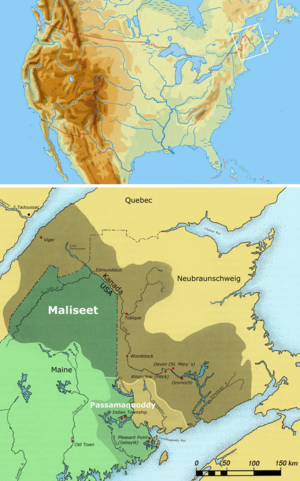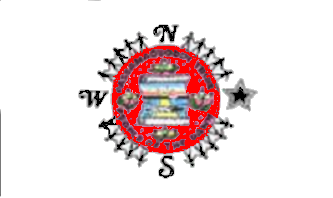Difference between revisions of "Passamaquoddy" - New World Encyclopedia
| Line 20: | Line 20: | ||
They invested the money well enough that they quickly increased it to $100 million. Their investing strategy was written up as a case study by [[Harvard Business School]]. <ref>{{cite book |last= Frazier |first= Ian |authorlink=Ian Frazier|title= On the Rez|year= 2001|publisher= Picador|isbn=978-0312278595 |pages=78-79}}</ref> | They invested the money well enough that they quickly increased it to $100 million. Their investing strategy was written up as a case study by [[Harvard Business School]]. <ref>{{cite book |last= Frazier |first= Ian |authorlink=Ian Frazier|title= On the Rez|year= 2001|publisher= Picador|isbn=978-0312278595 |pages=78-79}}</ref> | ||
| + | |||
| + | ==Passamaquoddy Pleasant Point Reservation== | ||
| + | '''Passamaquoddy Pleasant Point Reservation''' is an Indian reservation in [[Washington County, Maine|Washington County]], [[Maine]], [[United States]]. The population was 640 at the 2000 census. | ||
| + | |||
| + | |||
| + | According to the [[United States Census Bureau]], the Indian reservation has a total area of 1.2 [[km²]] (0.5 [[square mile|mi²]]), all land. | ||
| + | |||
| + | |||
| + | As of the [[census]][[Geographic references#2|<sup>2</sup>]] of 2000, there were 640 people, 233 households, and 160 families residing in the Indian reservation. The [[population density]] was 525.8/km² (1,376.2/mi²). There were 256 housing units at an average density of 210.3/km² (550.5/mi²). The racial makeup of the Indian reservation was 9.38% [[White (U.S. Census)|White]], 88.59% [[Native American (U.S. Census)|Native American]], 0.31% from [[Race (United States Census)|other races]], and 1.72% from two or more races. [[Hispanic (U.S. Census)|Hispanic]] or [[Latino (U.S. Census)|Latino]] of any race were 1.25% of the population. | ||
| + | |||
| + | There were 233 households out of which 43.8% had children under the age of 18 living with them, 29.6% were [[Marriage|married couples]] living together, 27.5% had a female householder with no husband present, and 31.3% were non-families. 27.9% of all households were made up of individuals and 6.4% had someone living alone who was 65 years of age or older. The average household size was 2.74 and the average family size was 3.27. | ||
| + | |||
| + | In the Indian reservation the population was spread out with 35.2% under the age of 18, 10.3% from 18 to 24, 31.7% from 25 to 44, 15.9% from 45 to 64, and 6.9% who were 65 years of age or older. The median age was 29 years. For every 100 females there were 96.9 males. For every 100 females age 18 and over, there were 102.4 males. | ||
| + | |||
| + | The median income for a household in the Indian reservation was $15,956, and the median income for a family was $22,500. Males had a median income of $23,333 versus $22,500 for females. The [[per capita income]] for the Indian reservation was $9,096. About 36.7% of families and 38.3% of the population were below the [[poverty line]], including 40.5% of those under age 18 and 31.6% of those age 65 or over. | ||
| + | |||
| + | |||
== Special political status in Maine == | == Special political status in Maine == | ||
| Line 51: | Line 68: | ||
| − | {{Credits|Passamaquoddy|160941574|}} | + | {{Credits|Passamaquoddy|160941574|Passamaquoddy_Pleasant_Point_Reservation|128868160|}} |
Revision as of 13:20, 2 October 2007
The Passamaquoddy (Peskotomuhkati or Pestomuhkati in the Passamaquoddy language) are a Native American/First Nations people who live in northeastern North America, primarily in Maine and New Brunswick. The Passamaquoddy lacked a written history before the arrival of Europeans but do have extensive coastal regions along the Bay of Fundy and Gulf of Maine and along the St. Croix River and its tributaries. They dispersed and hunted inland in the winter; in the summer, they gathered more closely together on the coast and islands and farmed corn, beans, and squash, and harvested seafood, including porpoise. The name "Passamaquoddy" is an Anglicization of the Passamaquoddy word peskotomuhkati, the prenoun form (prenouns being a linguistic feature of Algonquian languages) of Peskotomuhkat (pestəmohkat), the name they applied to themselves. Peskotomuhkat literally means "pollock-spearer" or "those of the place where polluck are plentiful",[1] reflecting the importance of this fish. [1] Their method of fishing was spear-fishing rather than angling.
The Passamaquoddy were moved off their original lands repeatedly by European settlers since the 16th century and were eventually limited in the United States to the current Indian Township Reservation in eastern Washington County, Maine. It has a land area of 96.994 km² (37.450 sq mi) and a 2000 census resident population of 676 persons. There are also Passamaquoddy off-reservation trust lands in five Maine counties; these lands total almost four times the size of the reservation proper. They are located in northern and western Somerset County, northern Franklin County, northeastern Hancock County, western Washington County, and several locations in eastern and western Penobscot County. Their total land area is 373.888 km² (144.359 sq mi). There was no resident population on these trust lands as of the 2000 census. The Passamaquoddy also live in Charlotte County, New Brunswick, and maintain active land claims but have no legal status in Canada as a First Nation. Some Passamaquoddy continue to seek the return of territory now comprised in St. Andrews, New Brunswick which they claim as Qonasqamkuk, a Passamaquoddy ancestral capital and burial ground.
The Passamaquoddy population in Maine is about 2,500 people, with more than half of adults still speaking the Maliseet-Passamaquoddy language, shared (other than minor differences in dialect) with the neighboring and related Maliseet people, and which belongs to the Algonquian branch of the Algic language family.
Passamaquoddy Bay, which straddles the United States-Canada border between New Brunswick and Maine, derives its name from the Passamaquoddy people.
Land claims lawsuit
The Passamaquoddy may be best known outside the region for Passamaquoddy v. Morton, a 1975 land claims lawsuit in the United States which opened the door to successful land claims negotiations for many eastern tribes, giving federal recognition and millions of dollars to purchase trust lands. The Passamaquoddy tribe were awarded $40 million at the resolution of this case by the Maine Land Claims Act of 1980, signed on March 15, 1980, with a similar sum paid to the Penobscot tribe, in return for relinquishing their rights to 19,500 square miles, for roughly 60% of the State of Maine. Most Penobscot live on a reservation at Indian Island, which is near Old Town.
They invested the money well enough that they quickly increased it to $100 million. Their investing strategy was written up as a case study by Harvard Business School. [2]
Passamaquoddy Pleasant Point Reservation
Passamaquoddy Pleasant Point Reservation is an Indian reservation in Washington County, Maine, United States. The population was 640 at the 2000 census.
According to the United States Census Bureau, the Indian reservation has a total area of 1.2 km² (0.5 mi²), all land.
As of the census2 of 2000, there were 640 people, 233 households, and 160 families residing in the Indian reservation. The population density was 525.8/km² (1,376.2/mi²). There were 256 housing units at an average density of 210.3/km² (550.5/mi²). The racial makeup of the Indian reservation was 9.38% White, 88.59% Native American, 0.31% from other races, and 1.72% from two or more races. Hispanic or Latino of any race were 1.25% of the population.
There were 233 households out of which 43.8% had children under the age of 18 living with them, 29.6% were married couples living together, 27.5% had a female householder with no husband present, and 31.3% were non-families. 27.9% of all households were made up of individuals and 6.4% had someone living alone who was 65 years of age or older. The average household size was 2.74 and the average family size was 3.27.
In the Indian reservation the population was spread out with 35.2% under the age of 18, 10.3% from 18 to 24, 31.7% from 25 to 44, 15.9% from 45 to 64, and 6.9% who were 65 years of age or older. The median age was 29 years. For every 100 females there were 96.9 males. For every 100 females age 18 and over, there were 102.4 males.
The median income for a household in the Indian reservation was $15,956, and the median income for a family was $22,500. Males had a median income of $23,333 versus $22,500 for females. The per capita income for the Indian reservation was $9,096. About 36.7% of families and 38.3% of the population were below the poverty line, including 40.5% of those under age 18 and 31.6% of those age 65 or over.
Special political status in Maine
The Passamaquoddy, along with the neighboring Penobscot Nation, are given special political status in the U.S. state of Maine. Both groups are allowed to send a nonvoting representative to the Maine House of Representatives. Although these representatives cannot vote, they may sponsor any legislation regarding Native American affairs, and may co-sponsor any other legislation. They are also entitled to serve on House committees.
Notable Passamaquoddy
- Melvin Francis, Tribal Governor
- Maggie Paul, singer[2]
- Allen Sockabasin, singer, writer, and translator (b. 1944)[3]
Popular culture references
- Members of the Passamaquoddy tribe appear in the PBS series Colonial House.
- Passamaquoddy is the name of a fictional, turn-of-the-century, seaside fishing village in Maine, presumably near Passamaquoddy Bay, in the Disney movie Pete's Dragon.
Notes
- ↑ Erickson, Vincent O. 1978. "Maliseet-Passamaquoddy." In Northeast, ed. Bruce G. Trigger. Vol. 15 of Handbook of North American Indians, ed. William C. Sturtevant. Washington, D.C.: Smithsonian Institution, pg. 135. Cited in Campbell, Lyle (1997). American Indian Languages: The Historical Linguistics of Native America. Oxford: Oxford University Press, pg. 401.
- ↑ Frazier, Ian (2001). On the Rez. Picador, 78-79. ISBN 978-0312278595.
ReferencesISBN links support NWE through referral fees
- Indian Township Reservation and Passamaquoddy Trust Land, Maine United States Census Bureau
External links
- Passamaquoddy Tribal Government Web Site (Pleasant Point)
- Passamaquoddy Tribal Government Web Site (Indian Township)
- Maliseet-Passamaquoddy online dictionary
- Contribution to Passamaquoddy Folk-Lore, by J. Walter Fewkes, reprinted from the Journal of American Folk-Lore, October-December, 1890, from Project Gutenberg
- Passamaquoddy Origins
Credits
New World Encyclopedia writers and editors rewrote and completed the Wikipedia article in accordance with New World Encyclopedia standards. This article abides by terms of the Creative Commons CC-by-sa 3.0 License (CC-by-sa), which may be used and disseminated with proper attribution. Credit is due under the terms of this license that can reference both the New World Encyclopedia contributors and the selfless volunteer contributors of the Wikimedia Foundation. To cite this article click here for a list of acceptable citing formats.The history of earlier contributions by wikipedians is accessible to researchers here:
The history of this article since it was imported to New World Encyclopedia:
Note: Some restrictions may apply to use of individual images which are separately licensed.

